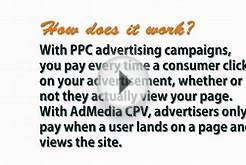Cost-per-view (CPV) bidding is the default way to set the price you'll pay for your TrueView video ads (when created with AdWords). With CPV bidding, you'll pay for video views and other video interactions (such as clicks on the call-to-action overlays (CTAs), cards, and companion banners), whichever comes first.
With traditional online text ads or image ads, customers on the web may see your ad, read its text, and click your URL to go directly to your site. This type of interaction doesn't take interactive content like video ads into account.
With video ads reporting, you can evaluate how engaged viewers are with your content, where they choose to watch your videos, and when they drop off from watching your content.
Setting a CPV bid
To set a CPV bid, you enter the highest price you want to pay per view while setting up your video campaign and ad groups. Your bid is called your maximum CPV bid, or simply "Max. CPV." This bid applies at the ad group level.
Example
If you think it's worth 25 cents to have someone watch your video, you can set US$0.25 as your max CPV. For a TrueView in-display video ad, you'll pay a maximum of US$0.25 when people begin watching your video. For TrueView in-stream video ads, you'll pay a maximum of US$0.25 when someone chooses to watch your video or clicks on the call-to-action overlays (CTAs), cards, and companion banners.
You can also set a lower bid for your in-display video ads than for your in-stream video ads.
How CPV affects your ad rank
The max CPV you set helps determine your ad's chances of winning the auction and appearing to viewers.
For TrueView in-display ads running on the YouTube Search Network, it can also affect its position among other ads on the search results page.
In both cases, a higher CPV will increase your ad's chances of appearing, and increase your ad's chances of appearing in a higher position compared to other advertisers' ads, if applicable.
Your actual CPV
Your maximum CPV bid is the most you'll be charged for a video view, but you won't always be charged this maximum amount. Wherever possible, we'll try to charge you only what's necessary for your ad to appear on the page. The final amount you actually pay for a view is called the actual CPV(cost-per-view).
Actual CPV is often less than max CPV because with the AdWords auction, you pay no more than what's needed to rank higher than the advertiser immediately below you.
Two other elements affect the actual CPV you pay: Quality Score and ad rank. Your Quality Score is a measure of how relevant your ad is to a customer, and includes multiple performance factors like view rates. Once your Quality Score is determined, it's multiplied by your max CPV bid to rank your ads among other advertisers. That's called Ad Rank.
Once all ads have been ranked, the actual CPV for your ad is based on an equation that considers the ad rank of the bidder below you and your Quality Score.
The highest ranked ad wins, and the cost for a video view of this ad (the Actual CPV) will be just above the CPV bid of the next ranking ad.
Let's say your max CPV is $5.00, and there are two other advertisers in the auction with you with the same Quality Score. One bids a CPV of $1.00, and another bids a CPV of $3.00. Since there are no other competitors bidding more than $5.00, you're the top bidder. However, we're not going to charge you $5.00 if your closest competition is only bidding $3.00. We'll charge you $3.01 for your video play.
How to set your CPV bid
You can set your max CPV bid when setting up your campaign as you select your ad groups. You can select a max CPV bid for all ads associated with an ad group.

















